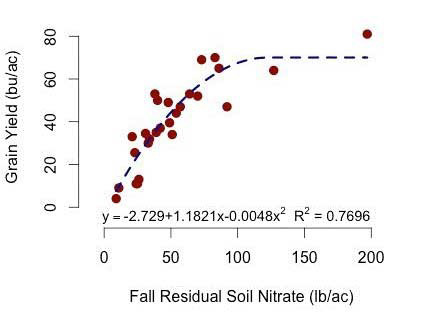A separate article in this eUpdate provides guidance on planning an effective wheat fertility program through timely soil testing. This companion piece explores a specific aspect of that plan, the relationship between fall soil profile nitrate-N levels and wheat yield.
For many years, taking 24-inch soil profile-N samples in the fall has been a recommended practice for making an N recommendation for winter wheat. However, due to the mobility of nitrate-N in the soil, soil test values observed in the fall may differ from those observed in the spring, particularly on soils prone to leaching. Because many producers wait until spring green-up to make their N application, does soil sampling in the fall for nitrate really provide useful information for N management in wheat? That is a legitimate question.
What Research Shows
In K-State trials where no N fertilizer was applied, there was a strong positive relationship between fall nitrate-N levels and final wheat yield (Figure 1)

Figure 1. Relationship between fall soil profile nitrate-N level and wheat yield with no N fertilizer applied. Graph by Dorivar Ruiz Diaz, K-State Research and Extension.
When fall nitrate-N levels were low, wheat yields responded well to fertilizer. When nitrate-N levels exceeded 80–100 lb/acre, additional spring-applied N rarely increased yield. In short, fall nitrate-N levels are a reliable predictor of whether or not a crop will benefit from additional N fertilizer. This makes soil sampling in the fall an important tool for maximizing yield and efficiency.
When soil sampling for N is not done, the K-State fertilizer recommendation formula defaults to a standard value of 30 lb/acre available N. In this particular dataset, the average profile N level was 39 lb N/acre. However, the N level at individual sites ranged from 11 to 197 lbs N/acre. Most recommendation systems default to a standardized set of N recommendations based on the yield goal and/or the cost of N.
In Summary
Without soil sampling or some other method of estimating available N, such as crop sensing, N recommendations will be inaccurate. Failure to account for the N present in the soil wastes a valuable resource. It can result in excess foliage, increased plant disease, inefficient use of soil water, and reduced yield.
Fall soil profile testing for nitrate-N continues to play a valuable role in efficient N management for winter wheat in Kansas. It’s a cost-effective way to fine-tune your fertilizer program, avoid unnecessary inputs, and protect both yield and the environment.
Dorivar Ruiz Diaz, Nutrient Management Specialist
ruizdiaz@ksu.edu
Tags: wheat fertilizer profile nitrate residual nitrate soil fertility